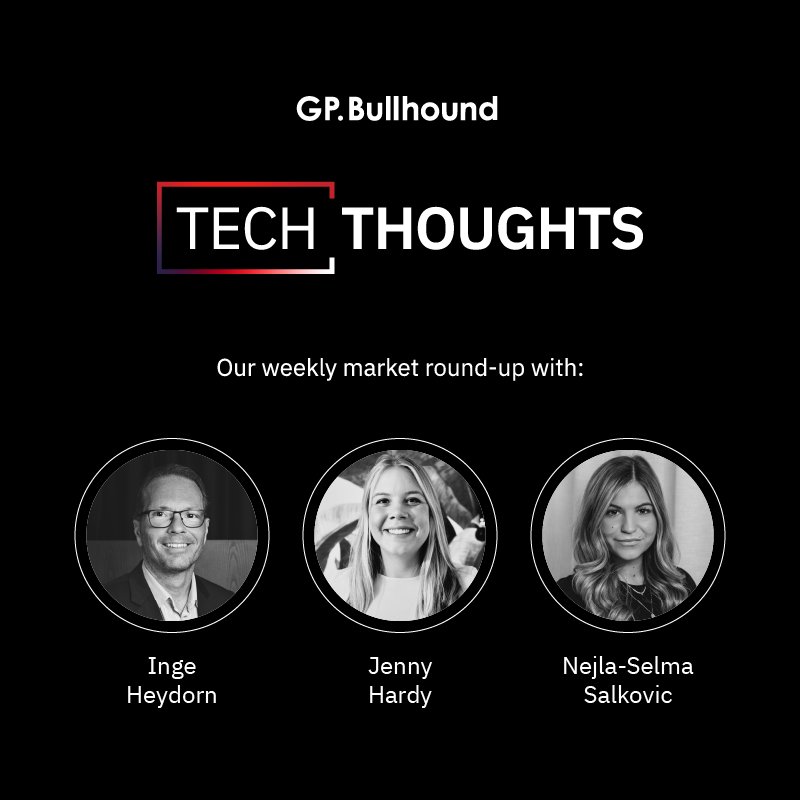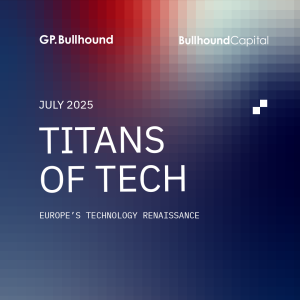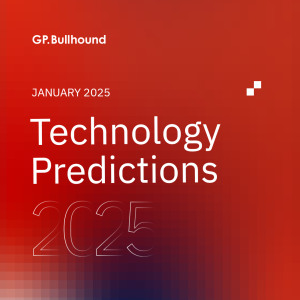Tech Thoughts Newsletter – 22 September 2023.

Market: There was lots of volatility post the Fed this week, who signalled rates will remain higher for longer, leading to higher yields and markets (and tech) falling. Large-scale M&A is back in tech – the Cisco/Splunk deal at $28bn is one of the largest we can think of in recent history.
Portfolio: We made no major changes in the portfolio this week in our long-only fund GTF, while we closed our short position in Disney in the hedge fund.
On the Fed, higher interest rates and “cash burn” as it relates to tech – the companies that are really exposed to interest rate rises are those with leveraged balance sheets. The tech sector as a whole – and indeed the companies we own – don’t have leverage – they’re cash-rich and cash-generative. Most of our portfolio is either paying a dividend or have buyback programs.
There is some impact on tech through discount rates and the resulting multiple, which we’ve seen already deflate the tech sector multiple. The most impacted within tech should be the stocks with more of their value in the terminal – typically the very high growth, highly rated parts of the sector – which are (just mathematically) more sensitive. Our investment philosophy as a team is to focus on companies’ financial productivity and ability to sustain that over a long time given competitive advantages. This, in turn, leads to a focus on cash flows and return on invested capital of the businesses we own, and their ability to compound those (through reinvestment) over time. That focus typically leads us away from the more interest-rate-sensitive parts of the sector.
Additionally, the businesses we own in the portfolio are still fundamentally compounding earnings – Nasdaq is back where it was at the end of 2020, but for most of the companies we own, earnings have compounded for three years since then – it makes us comfortable with the price levels and multiples of the stocks we own.
Onto newsflow:
AI as an enterprise opportunity for platform software businesses
- ServiceNow (owned) announced “Now Assist”, which is its product embedding Generative AI across its Now platform.
- As we commented last week with the Salesforce AI announcement, the use cases are compelling for those platform software businesses that can operate AI across a suite of apps.
- For ServiceNow, adopting these generative AI capabilities will be a meaningful uplift to ARPU (60% list price uplift), and we think it can significantly extend ServiceNow’s runway of >20% revenue growth.
- Microsoft (owned) announced that its Microsoft 365 Copilot will launch on November 1st. Microsoft has already announced that M365 Copilot pricing is $30/user/month. Back of the envelope ~400m commercial Microsoft 365 users, 30 x 12 x 400m = $144bn of potential annual sales increase (who cares about Bing?).
- We’ve spoken before that AI as an enterprise opportunity makes sense. Established enterprise software businesses can (1) leverage very large installed bases to upsell AI features; (2) have large cash balances to invest in AI; (3) have the right business model for AI to match the increased cost – ie. Subscription.
- And for enterprise software customers, it makes much more sense to get AI capabilities via their existing platform software providers (Microsoft, Workday, ServiceNow, Salesforce, Adobe can also benefit from upselling AI features) than to try to implement it themselves.
Portfolio view: The question for us in software and AI has been when and if AI starts to be a meaningful revenue generator (via ARPU uplift) for software companies rather than the current cost of doing business.
We ultimately think AI will lead to more consolidation of spend in the space, and those “platform-like” software businesses (we own Microsoft, ServiceNow, Salesforce, Workday and Adobe) are the best positioned both from a scale of investment and from a product set perspective (with an ability to leverage AI tools across a broad product suite).
Cisco buying Splunk – large-scale M&A is back
- Cisco (owned) announced it intends to acquire Splunk for $157 a share, a 30% premium, and $28bn takeout value – a big deal indeed (one of the largest in recent history we can think of).
- It’s all cash, expected to close in Q3 24, and we don’t expect it to need Chinese approval (which has been a bit of a barrier to getting M&A done of late). Cisco expects the deal to be cash flow and GM accretive in the first year and EPS accretive in year two.
- It will take Cisco from a comfortable net cash ($17bn) to a net debt company, not hugely concerning. Cisco management indicated they would continue the capital return/dividend program (tech changed).
- For Cisco, we’ve spoken before about it moving away from being a “turns” business towards more visible ARR/renewal-type revenue. The deal makes sense from that perspective and for Cisco prioritising its security and observability businesses.
Portfolio view: We own Cisco, partly for the transformation to a more recurring revenue business, which Splunk helps with. It’s also the case that Cisco’s strategy of acquiring smaller businesses simply hasn’t worked quickly enough to build up those parts of the business. We’re always sceptical about acquisitions as a fix, but there are clearly synergies and Splunk has good technology which Cisco’s sales force and distribution can leverage.
Semicap equipment – Intel and TSMC race vs pushouts; NAND prices
- There’s a bit to talk about in the semicap space this week – which is an area we remain exposed to in the portfolio.
- Intel held its annual innovation conference this week. We don’t own Intel (it’s a structural share loser – which we detail below), but it’s an important company to follow given (1) it’s in the top three semiconductor equipment spenders – a sector we’re exposed to; and (2) as a competitor to AMD, Nvidia and TSMC (all owned).
- No surprise that AI was the key feature, with (our take) Intel still clearly fighting for relevance (more on that below).
- On the semicap equipment spending though, Intel CEO Pat Gelsinger reiterated the aim of upgrading its manufacturing processes, with Intel 3 aiming to be ready at the end of this year.
- They also reiterated the Meteor Lake launch in Q4. That will be on Intel 4, which is 7nm and is Intel’s first EUV process for mass production.
- Having fallen quite dramatically behind TSMC, it’s trying to move back to leadership within its manufacturing business (it not only hopes to be back to leadership when it comes to manufacturing its own chips, but is also trying to become a foundry business and compete directly with TSMC).
- At the same time this week, there have been more rumours of TSMC pushing out their 2nm fab in Taiwan. We believe that there could indeed be some pushouts (TSMC has commented that they’ve been unable to find enough qualified engineers – particularly in its Arizona facilities), but given Intel pushing ahead (and remaining on time), we think any pause we see at TSMC will be very short – and we think this ongoing tech leadership race (between Intel, TSMC and Samsung) will continue to drive the sector.
- Lastly, NAND memory spot prices are increasing significantly – in part driven by Huawei spending, but it’s a market dynamic that has in the past led to higher semicap spending. Memory pricing is incredibly cyclical and it’s typically in those periods of higher prices that you see memory manufacturers committing to more spend.
Portfolio view: Intel’s return to leading-edge manufacturing is totally dependent on it building up leading-edge fabs and adopting EUV/High NA – which are already in ASML’s order books. It has only a handful of EUV machines in production. For context, we think (as a rough estimate) that TSMC has about 100 tools in production. That’s an extraordinary level of catch-up required – and we think Intel will be a significant driver of orders for ASML over the next 2-3 years. Intel is forced to invest in trying to catch up for the last 10 years of underinvestment – we are sceptical as to whether it will succeed but will continue to benefit from it trying through ASML and the other semicap equipment names we own in the portfolio. It also means that TSMC will be forced to keep investing to avoid falling behind. The leadership race is a big part of what drives our strong structural view on the sector.
Intel’s priorities point to a lost battle in cloud GPU
- The other takeaway from the Innovation Day is that we think Intel is focusing more on trying to capture the Edge/end device opportunity, which probably makes sense given how far behind it is now in the GPU/LLM space.
- It does have a GPU alternative to Nvidia – Gaudi, which is seeing a good deal pipeline. But the edge opportunity – given its PC dominance – makes the most sense for Intel.
- And AI workloads happening at the edge where they can (either at the network edge or end device) make sense too – both from a cost and a latency perspective.
Portfolio view: To the extent that Intel appears to have nearly given up on the cloud GPU space, it shows Nvidia’s clear leadership. On the CPU opportunity, we still back AMD to be the winner in CPU workloads within AI, where it has a significant performance leadership over Intel. We own both Nvidia and AMD.
Advertising – Retail media and Instacart’s IPO, and Google’s defence
- Martin Sorrell’s S4 Capital issued another profit warning (it last warned in July) in the advertising space, noting that summer saw “slower than expected trading” and longer sales cycles, particularly with technology clients. It’s nothing new and not unexpected – technology companies cutting sales and marketing spend has been a significant margin benefit for the whole sector this year.
- On the other side of that, Interpublic’s Magna increased its full-year forecast for US ad spend this week, particularly benefiting from digital media spend (where there is still a benefit of the offline->online shift). Magna is less concentrated on the tech sector, and it called out travel, pharma, retail and CPG as strong.
- It also called out Retail Media as being a new avenue of spend – we’ve spoken before about Walmart and Amazon capturing more advertising budget.
- Relatedly, Instacart IPO’d this week. Most interesting for us is its own advertising business, which accounts for close to 30% of total revenue (and presumably a much larger share of profit) – which is probably the part that makes it legitimately qualify as a tech company (we didn’t participate in the IPO).
- This week Google was keen to point out new retail advertising competition in its antitrust trial – on Tuesday, one of its VPs argued, “we are losing share to other new entrants”, specifically calling out TikTok and Amazon.
Portfolio view: We don’t own any ad agency names, but the ad weakness they’re seeing relates to more budget scrutiny everywhere (it’s not all bad news in tech as we see typically better margins and, indeed, cost cutting remains a significant lever tech companies have available to pull).
Cyclically, in 2023, digital advertising growth has slowed, and new competition is taking engagement (and therefore spend) away from incumbent social platforms. There has also been a mixed shift towards more search-based/targeted media – including new areas of spend like retail media – remember Amazon’s advertising business is $10bn/quarter and growing over 20%.
Our direct exposure in the portfolio to digital ad spend is Google, where we see search as relatively more resilient, with a still evident ROI for advertisers (but of course, it’s no surprise that Google wants to highlight its new competitors to the DoJ).
Auto – European shift to EV continues
- European auto numbers for August were solid – up 21% yr/yr, and importantly, the share of battery-electric cars exceeded 20% for the first time (up from 11.6% a year ago); Hybrid at 24%. Combustion engine vehicles lost 6 points of market share in a year.
- It’s extraordinary growth, and auto is still the one bright spot of economic data globally (we’ve commented a lot about the positive China export data). There are lots of things driving this, including likely still some hangover from the Covid component shortages, but also EU regulations around EV driving quite aggressive pricing from OEMs (we commented last week on the price wars and the EU challenges to China around subsidies distorting the pricing).
Portfolio view: For us, what’s interesting in tech are the power semis companies that benefit from a 2-3x semis content increase in the move from ICE to EV. We own NXP and Infineon, where we think their power semis remain largely sold out for the rest of the year.

For enquiries, please contact:
Inge Heydorn, Partner, at inge.heydorn@gpbullhound.com
Jenny Hardy, Portfolio Manager, at jenny.hardy@gpbullhound.com
Nejla-Selma Salkovic, Analyst, at nejla-selma.salkovic@gpbullhound.com
About GP Bullhound
GP Bullhound is a leading technology advisory and investment firm, providing transaction advice and capital to the world’s best entrepreneurs and founders. Founded in 1999 in London and Menlo Park, the firm today has 14 offices spanning Europe, the US and Asia.



